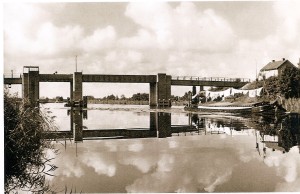The B Squadron of the Royal Canadian Dragoons departed from Oosterwolde on the morning of 14 April 1945, intending to reach northern Friesland. By doing so, they aimed to effectively sever the connections between German troops in Friesland and Groningen.
The Canadians were guided by members of the Dutch resistance, including sabotage leader Piet Oberman. Oberman had joined the Canadians on 13 April, bringing with him a wealth of up-to-date intelligence.
The plan for 14 April was largely based on this information. Around 15:00, the Dragoons arrived at Drogeham and then continued to the bridge over the Knillesdjip / Kolonelsdiep at Kootstertille.
The Dutch Interior Forces (BS) had prepared a plan to occupy the bridge, but due to a misunderstanding, this did not take place. The BS had received information suggesting the bridge was mined and could be blown up by the Germans at any moment. Believing the bridge lost, the BS instead occupied the bridge at Blauwverlaat.
However, the Dragoons did not use the bridge at Blauwverlaat. Coming from the west, they reached Kootstertille first. Since the bridge was intact and unmined, the Canadians were able to use it to cross the Knillesdjip / Kolonelsdiep. The Dragoons then advanced rapidly northward, reaching Dokkum by early evening.
